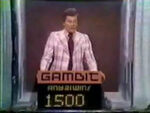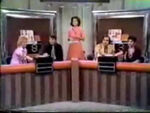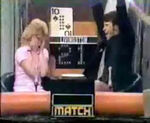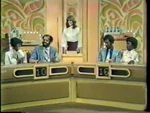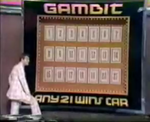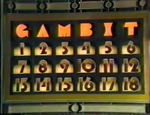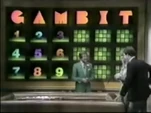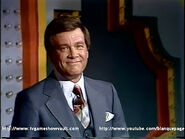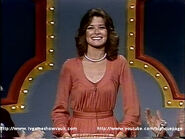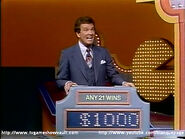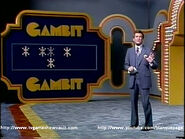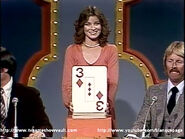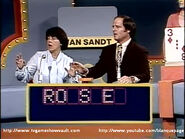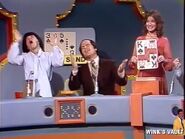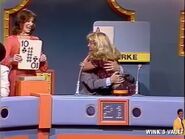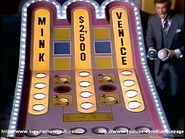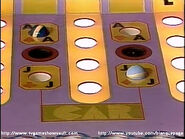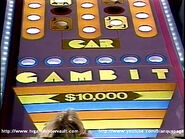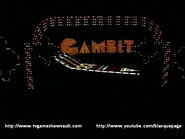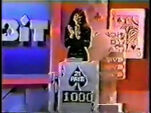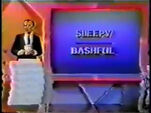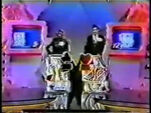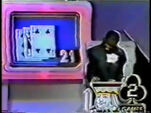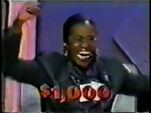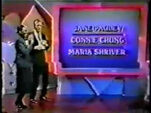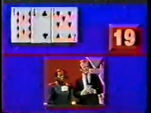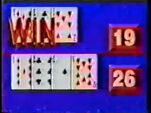| Hosts | |
| Wink Martindale (1972–1981) Tom Campbell (1985) Bob Eubanks (1990) | |
| Hostesses/Dealers | |
| Elaine Stewart (1972–1976) Debbie Bartlett (1979) Beverly Malden (1980–1981) Lee Menning (1981) Susie Fawcett (1990) | |
| Announcers | |
| Kenny Williams (1972–1981) John Harlan (1985) John Cramer (1990) | |
| Broadcast | |
| CBS Daytime: 9/4/1972 – 12/10/1976Unsold Pilots for NBC: 10/19/1979NBC Daytime: 10/27/1980 – 11/27/1981Unsold Pilot: 1985 Unsold Pilot for ABC: 10/20/1990 | |
| Packagers | |
| Merrill Heatter/Bob Quigley Productions (1972–1981) Merrill Heatter Productions (1985) Merrill Heatter Productions/Orion Television Entertainment (1990) | |
(Las Vegas) Gambit was a game based on Blackjack where players (mainly married couples) could win big if they played their cards right.
Gameplay[]
Main game[]
The object of the game was that of blackjack: come as close to 21 as possible without going over (or "busting"). As in blackjack, the cards 2 through 10 were worth their face value; face cards (Kings, Queens and Jacks) counted as 10 and an Ace could count as either 1 or 11.
Martindale asked a series of questions, usually multiple-choice or true-false, to two married couples. The couple who buzzed in and answered the question correctly won control of the next card from the top of a deck of 52 over-sized (but otherwise regulation) playing cards. If a couple buzzed in and missed the question, then the other couple got control of the next card. The first card was shown before the first question, but cards thereafter were presented face down.
Once a couple gained control of a card they had the option of adding it to their own hand or passing it to their opponents. After a couple received any card (whether by choosing to take it themselves or by having a card passed to them from their opponents) they could elect to "freeze" if they were in the lead (neither team was permitted to freeze when the two were tied), preventing them from receiving any additional cards. This rule prevented their opponents from passing cards to them in order to strategically force them to bust.
Once this happened, the other couple answered questions and received a card after each correct answer.
Conditions for winning[]
A game could be won in one of four ways:
- Reaching 21 in any combination, which not only won the game, but also broke the Gambit Jackpot, which started at $500 and went up $500 at the start of each day (or at the start of each match on Las Vegas Gambit), except that if it was won with the last card of the day, it started the next day at $500. The highest jackpot was $6,500. On the LVG premiere, it started at $2,500.
- Having their opponents exceed 21 ("bust"), even if the winners had no cards.
- Freezing, and then having the opponents miss a question before getting a higher score without going over 21.
- Having the opponents freeze, and then getting a higher score without going over 21.
Each game won was worth $100, and the first couple to win two games won the match and advanced to the bonus round.
Bonus Round[]
The Gambit Board[]
For the entire original series and the first half of Las Vegas Gambit, the winning couple played the Gambit Bonus Board. They faced a large game board with 21 numbered cards (18 numbered video screens on Las Vegas Gambit). Each card/screen concealed a prize; along with each prize the couple chose, they received a card added to their hand from the deck.
The game ended in one of three ways:
- The couple elected to stop before reaching 21 (especially if they feared the next card would push them over 21 or in some instances, if they won a desirable prize they wanted to keep) and keep all the prizes they had chosen to that point.
- Going over 21, at which point they lost everything from the board.
- Reaching 21 exactly, wherein they won a new car as well as the Gambit Jackpot and the prizes selected.
During the early episodes of Las Vegas Gambit, a couple could elect to stop only when their hand totaled 17 or more; in addition, getting 21 won just the Gambit Jackpot and the selected prizes. Within a few weeks, getting 21 won $5,000 plus the Jackpot and prizes.
Special Prizes (CBS Version)[]
There were a number of recurring prizes on the CBS version, including:
- "Anniversary Dinner" – The couple would be flown to a city on their next anniversary and treated to dinner; there were three of these on the board when this was played, each with a different city (usually two in Europe, but the third was always Burbank).
- "Suit" Cards – One card of each of the four suits of cards; each was worth $500, plus $500 for each card the couple got in that bonus round of that suit as long as they did not go over 21.
- "Football Games" – During December, trips to various football bowl games including the Rose Bowl, Sugar Bowl, Orange Bowl, and Cotton Bowl, were offered. A couple winning more than one of these trips would not be able to take all of them as they all occur around New Year's Day, and like most trips given away on game shows had to be taken within a year of winning them and could not be transferred.
- "Half-Checks" – The majority of the boxes on the board hide half checks. Left halves consisted of numbers 5 through 100 and the right halves consisted of two zeroes each. When a couple found a right half check full of zeroes and match it up with a left half, they would receive that money as long as they stayed under 21. Hitting 21 also kept it. If a couple found either half and not the other, but did not go over, they carried that half over to the next session of the Gambit Board if and when they made it there. The potential maximum was $10,000.
- "Top or Bottom" – Around the same time as the "Half-Checks", this prize offered contestants a choice between the top or the bottom. One choice had an expensive and desirable option, and the other had an inexpensive and perhaps not so desirable option. (For example, a Top or Bottom card reading "Cruise" might offer a cruise to the Caribbean or to Catalina Island.)
- "Hot Card" – If this card is hit, the value was set at an initial $100. It increased to $1,000 if the couple did not go over 21 and the hidden rank behind it matched one of the ranks the couple had on the board.
- "Swap" – This card allowed couples to switch any prizes won on the board (assuming they didn't go over 21) for another pick from the board.
- "Christmas Tree" – A graphic of a Christmas tree representing $1,000 and a Happy Holidays greeting from Wink.
Special Features (Las Vegas Version)[]
Las Vegas Gambit had its own special features, played when a couple stopped or won the end game, including:
- "Take Two" – The couple could pick two numbers on the next turn.
- "Stop or Go" – The dealer would reveal a card, the value of which would be multiplied by $100. The couple could then choose to attempt winning more cash by selecting another card, but would bust if the next card was the same suit as the first card dealt (i.e., if the first card was a club, another club would end the game), and thus lose all the cash accumulated up to that point.
- "100/200/500 Times" – The couple, assuming they did not go over 21, would receive one additional card not counted towards their final hand score, and be awarded $100/$200/$500 times the value of that card, worth $200–$1,100, $400–$2,200, or $1,000–$5,500.
- "Red or Black"
Beat the House[]
One feature on both versions was "Beat the House". Contestants winning this prize would have the opportunity to play one hand of blackjack "against the house" for $2,500 ($1,000 on LVG) using standard single-deck rules, with the possible exception being that there did not appear to be any cases in which contestants could "split" a pair (play each card of the pair as the basis of its own hand) or "double down" (draw a single additional card for twice the stakes) on a wager.
The Gambit Galaxy[]
The second half of Las Vegas Gambit featured "The Big Numbers", a game borrowed from another Heatter-Quigley game, High Rollers (which Wink would eventually host starting in 1987 in syndication). The couple was presented with a pair of dice and was asked to eliminate the numbers 1 through 9 from a board in front of them. To do this, the couple eliminated numbers that added up to the total they rolled (for instance, if the couple rolled a 10 they could eliminate 4 and 6; 3 and 7; 1, 2, 3, and 4; or any other combination that added to 10). The couple won $100 for each number they eliminated, and if all nine were eliminated, the couple won $5,000 and an accumulating prize package called the "Gambit Galaxy". The highest jackpot was $51,565. In the event a double was rolled (the same number on both dice), an insurance marker was awarded; it could then be used in the event the couple made a bad roll.
This version's last week of shows consisted of reruns from an earlier "Singles Week" (in which teams of two complete strangers were paired up to play the game, and at the end of the week all couples who won a match rolled the dice for the "Gambit Galaxy").
Las Vegas Gambit Pilot bonus round[]
The bonus round found on the Las Vegas Gambit pilot episode featured a "Living Deck", a group of 52 audience members each holding a different card. Every time the couple earned a prize, the audience member with the selected card would win the same prize.
From 1972 to 1976, returning champions continued until winning a grand total of $25,000, relinquishing any winnings over that amount. There was no winnings limit on Las Vegas Gambit.
From 1972 to 1975 the show featured an annual promotion where the first couple to get a two-card 21 (an Ace and a face card/10) in the bonus round won either $200 a week for a year (totaling $10,400) or a flat $10,000, depending on the year.
Broadcast history[]
CBS, 1972–1976[]
CBS put Gambit in originally at 11 a.m./10 Central, where it defeated NBC's Sale of the Century. It also easily beat Alex Trebek's American debut program, The Wizard of Odds, which NBC began in July 1973. On April 1, 1974 (the same day Now You See It with Jack Narz premiered), CBS moved the show ahead a half-hour to 10:30/9:30, where it faced NBC's struggling quiz Jeopardy!. NBC moved Jeopardy! to the afternoons on July 1 and placed one of the many Bill Cullen-Bob Stewart collaborations, Winning Streak, in the slot. That show's weakness made late 1974 the high point of Gambit’s original daytime run, at least in the Nielsen ratings.
However, Wheel of Fortune would debut on January 6, 1975. Not only did Wheel impact its competitor's audience, but NBC's expansion of Another World in the afternoons forced CBS to return The Price is Right to the morning after a two-year run at 3/2 Central. In order to make room for Price, the network decided to return Gambit to its original slot on August 18, where it remained for the rest of its run. At that slot, Gambit had to go against its sister Heatter-Quigley show High Rollers. The network canceled the four-year-old game two weeks before Christmas 1976, replacing it with Goodson-Todman's Double Dare.
NBC, 1980–1981[]
In June 1980, NBC canceled Heatter-Quigley's flagship show The Hollywood Squares and the revival of High Rollers in favor of a 90-minute (later 60) talk-variety show hosted by future late night icon David Letterman. When Letterman's effort failed miserably after a four-month run, the network obviously decided to make amends to the packager by reviving Gambit.
Plugging the show in at 10 a.m./9 Central, NBC found out, however, that many affiliates would not give the show a chance, due to the increasing popularity of syndicated talk shows like Donahue and Hour Magazine, which station managers thought would draw larger audiences (and, more importantly, larger local advertising revenues) than NBC offerings. Further, even though CBS ran sitcom reruns against Las Vegas Gambit, many of their stations carried those aforementioned syndicated offerings and often won their markets with those, instead of the network feed.
Las Vegas Gambit lasted 13 months. Over the next several months, NBC would rid itself of all the other games on its daytime schedule except for Wheel, which became NBC's sole daytime game show until January 1983. Las Vegas Gambit appeared to go into reruns toward the end of its run, as the finale (which was never intended to be such) was a repeat of an earlier episode. A picture-in-picture box was inserted during the end credits where Wink Martindale announced the finale; the series was replaced by a talk show hosted by Regis Philbin and future Entertainment Tonight hostess Mary Hart (a forerunner of what in time became Live With Regis And Kathie Lee) that was canceled shortly after its debut.
Episode status[]
The status of Gambit is unknown outside of one 1974 episode traded among collectors, a 1976 episode uploaded to YouTube by Wink Martindale himself, and five 1973 episodes held by the UCLA Film and Television Archive. The December 7 and December 10, 1976 episodes (4th-to-last show and the finale) from the CBS run are also confirmed to be held by Wink Martindale.
In Fall 1977, reruns of the CBS Gambit aired in syndication, most notably by WPIX in New York and KHJ in Los Angeles. It is then likely that this version still exists as CBS had mostly abandoned the practice of erasing older tapes by the early 1970s.
Ten regular episodes of Las Vegas Gambit currently exist, despite NBC scaling back its wiping practices by 1980. Among the episodes that exist is the final aired and the first aired episode. The pilot episodes exist also. Most of these surviving episodes exist as home recordings.
Pilots[]
Three pilots were made in an attempt to revive the series; none of them sold (and only one [mainly the 1979 version] used married couples like the original and Las Vegas versions) while both the 1985 and 1990 version used the single contestants format instead {three in the '85 version and two in the '90 version respectively}. Additionally, only one pilot [mainly the 1979 version] was hosted by the original host of Gambit & Las Vegas Gambit Wink Martindale while the other two were hosted by Tom Campbell [1985 version] and Bob Eubanks [1990 version] respectively.
1979 Pilot[]
This pilot was shot for NBC October 19, 1979. It featured Wink Martindale once again as the host and Debbie Bartlett as the dealer also like the original and Las Vegas version it featured two married couples as contestants and used the opening and music from the eventual Las Vegas Gambit.
While the basic structure of the front game remained intact (with the Gambit Jackpot starting at $500 plus that amount for every game not won), the general knowledge questions were replaced with clues, similar to the future Scrabble (the game show with Chuck Woolery not the board game of the same name), with the answers appearing as puzzles, similar to Wheel of Fortune, revealed on the "Gambit Answer Machine". Plus, instead of toss-ups, couples now took turns. On a couple's turn, the Answer Machine was activated. After hearing the clue, the couple in control hit their plunger to stop the machine and reveal how many words & letters were in the answer. That determination was indicated by neon boxes and the stars in the boxes indicate where the letters would be revealed. When all was said and done, the controlling couple had five seconds to solve the puzzle. A correct solution earned control of the card, but a failure gave control to the opponents.
NOTE: The sound that the Answer Machine made was later used as the dancing number sound on Battlestars.
The winners of each game get $250 instead of $100; as such, a match win was worth $500.
The bonus round was a complete departure from the "Gambit Board" format. It was a game called "6-Ball" and it was played on a giant Skeeball ramp, featuring three prizes, two "Aces", two "Jacks", and the letters in the word "GAMBIT". The winning couple was given six balls (three for each spouse). If two landed in a prize, they won that prize. If two landed in an "Ace" & "Jack", they won a car. If it landed in one of two red holes, that ball was dead. But if all six letters in the word "GAMBIT" lit up, the couple won $10,000. Once the ball fell into a letter hole, it was popped back out and remained in play. Letters that lit up carried over into the next end game.
1985 Pilot[]
This pilot featured former Camouflage (1980 version) host and Los Angeles DJ Tom Campbell as emcee. This time it featured three single contestants instead of married couples.
This version featured three contestants to start the round, each dealt a "free card" to start off. Campbell asked a series of multiple choice toss up questions. Answering a question correctly won the right to either take the next card or pass it off to an opponent. This process continued until either a player reached 21 or a player went over. At that point, the player in the lead won a bonus prize, and the player in second place was allowed to continue on. The player who either busted or had the least amount of points was eliminated.
Round 2 was called "Beat the House". This time, a free card was dealt to both players, and to a rack next to Campbell. Again, players would be asked multiple choice questions, correct answers winning control. However, in this round, a player not only had to top their opponent, but also the "house" (the hand managed by Campbell). The house would take a card if it had 17 points or fewer, but would never pass a card to a player. If a player reached 21 or beat both the house and the opponent, he/she moved on to the bonus. If the house beat both players, Campbell asked a sudden death question to determine the winner.
The bonus round was named "Double Blackjack". The player would play two separate hands of blackjack, starting with a free card in each. One at a time, the player would draw cards off the deck and place them into either of the two hands. The player won $25 a point per card on the board. Getting a single 21 won a special prize (a trip to Holland on this pilot), and getting a double 21 was also worth a new car.
1990 Pilot[]
A pilot for another revival was shot for ABC on October 20, 1990 with Bob Eubanks as host and Susie Fawcett as dealer and like the 1985 pilot it featured two single contestants instead of married couples.
After the first card was shown, two answers were put on what was known as "The Gambit Screen" and Bob read a statement. The first to buzz-in either guessed if the statement applied to both of them, one (naming that one in the process) or neither. If they were right, they earned control of the first card, if not their opponent did. They could keep it or pass it to their opponent. The rest of the cards in the game were not shown. After getting control, the contestant decided where an unknown card went. If they exceeded 21 at any time, they lost. A player was allowed to freeze their hand when his/her score was at least 12 if they felt they had enough to win or feared that the next card would bust him/her out. This forced the other into solo play where they had to keep answering questions to receive cards. They had to beat their opponent without busting to win. If they busted or failed to answer a question, their opponent won the game. If they beat the score, they won the game. If anyone scored 21, they won the game and the Gambit Jackpot, this time starting at $1,000 and still growing by $500 per match. Each game was worth $100, and the first to win two games won the match and advanced to the Beat the House bonus game.
The third game in a match, if needed, was played differently. The champion decided where the first unknown card went. Then they received the next card by default. Following this, questions were brought back into play as above.
In the bonus round, the winner tried to beat the dealer. They had five chances for cards. Three answers were now revealed, and they had to decide whether statements applied to none, one, two or all three items. If they got a question right, they earned a card. They could continue up to five cards or when they wanted to freeze. After their hand was set, the dealer began drawing cards. They would draw as long as their total was 16 and below and stayed at 17 and above. If the dealer busted or did not beat the player (by having a lesser score or tying), the contestant won $5,000. But in the player's half of the round if he/she got 21, they won $10,000.
Orion (which had acquired the rights to the Heatter-Quigley library) was going through financial problems at the time, and the pilot did not sell.
2008 Good Morning America segment[]
After 28 years, Martindale returned to play one round of Gambit for ABC's Good Morning America on August 20, 2008 as part of its Play it Again! Game Show Reunion Week. Also featuring during that week were Let's Make a Deal and The Newlywed Game, both of which also featured their original hosts. One round was played, with Robin Roberts as the dealer.
International Versions[]
Australia[]
An Australian version produced for the Nine Network briefly aired in 1974. The host was Peter Hitchener and the dealer was Ros Wood. It was produced by the Reg Grundy Organization.
United Kingdom[]
A British version of the show was produced by Anglia Television for ITV, notable for its opening title sequence featuring various casino equipment including playing cards, casino chips, a roulette wheel and a fruit machine. It started in 1975 as a program shown in the Anglia region only, but became a networked show in 1978 and ran until 1985. The original host was Fred Dinenage from 1975 until 1983, later succeeded by comedian Tom O'Connor from 1984 until 1985. The original card dealer was Ann Dunsford in 1975 who was later replaced by Michelle Lambourne from 1976 until 1985. Ten years later, the program briefly returned from 23 July (July 23) until 5 November (November 5) 1995, but only in the Anglia region and was hosted by Gary Thompson while the dealer was Joanna Park.
In the ITV version, each game was worth £20. The Gambit Jackpot started at £200 and increased by £50 until won or until it hit £500. Also, no cars were originally offered in the end game (from 1981 onwards, they did offer a car as one of the star prizes). The cards used on this version had the same design as the U.S. version.
Trivia[]
The original version historically premiered on the same day as The Joker's Wild hosted by Jack Barry and The Price is Right (originally called The New Price is Right at the time) hosted by Bob Barker on CBS in 1972. Price has still continued running to this day since then, now with Drew Carey at the helm as host.
Rating[]
Music[]
1972 – Mort Garson
1980 – "Hollywood Boulevard" by Stan Worth
Studios[]
CBS Television City, Los Angeles, CA (1970s Version)
NBC Studios, Burbank, CA (1979 Pilot)
Fountain Theater, Tropicana Hotel, Las Vegas, NV (1980s Version)
Inventor[]
Wayne Cruseturner for Merrill Heatter-Bob Quigley Productions
| This page uses Creative Commons Licensed content from Wikipedia (view authors). |
Unreleased Merchandise[]
Two attempts to do a board game version of the show was planned by Milton Bradley in 1973 and 1981, but they were cancelled before they got manufactured, despite the higher ratings of the CBS version during the 1970s run.
Additional Pages[]
Spin-Offs[]
Casino - Unsold pilot for GSN in 2002.
Catch 21 - Show aired by GSN in 2008 along with a reboot in 2019.
Links[]
Curt Alliaume's Game Shows '75: Gambit
Rules for Gambit @ loogslair.net
Gambit @ Game Show Galaxy
Gambit @ Tim's TV Showcase
The 1990 Gambit Pilot Page
YouTube Videos[]
A Recently Unearthed Clip
Gambit - Full Rare Episode
Final Episode of Las Vegas Gambit
The 1990 Gambit Pilot
Gambit "Run Thru" Opening Animation








